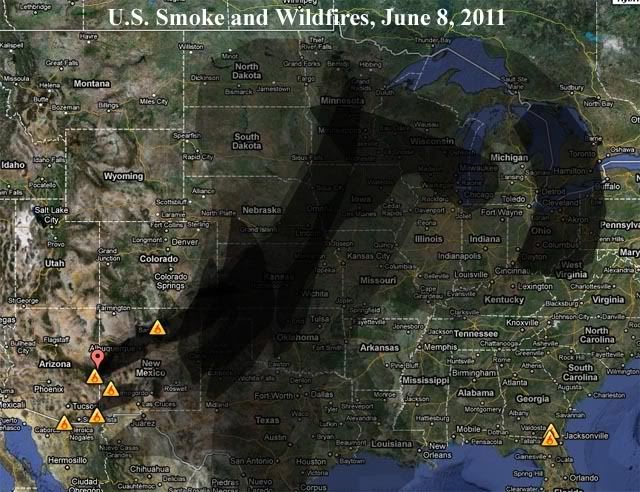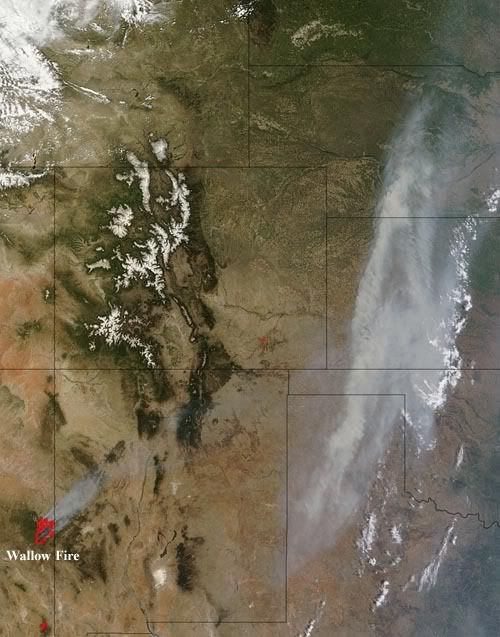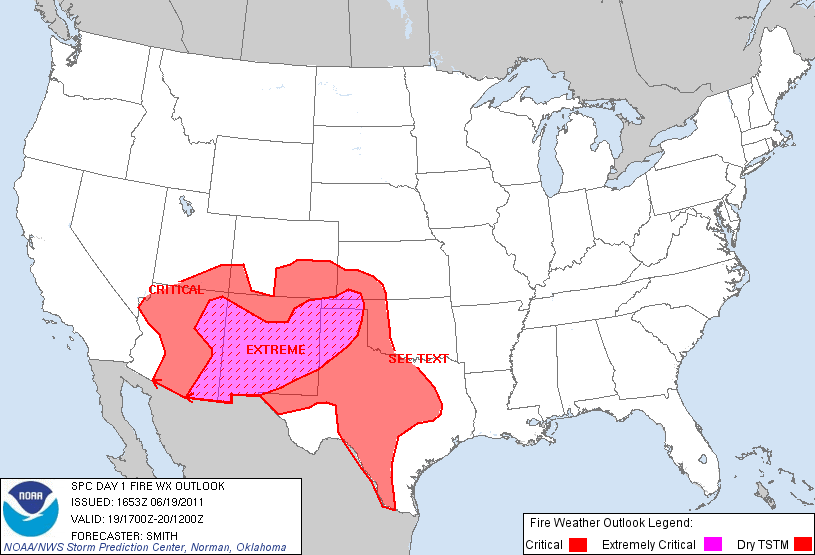
quote:Duizenden op de vlucht voor bosbrand Arizona
In de Amerikaanse staat Arizona zijn meer dan 2.300 brandweermannen bezig om een van de grootste branden die het gebied ooit heeft getroffen, onder controle te krijgen. Dat meldt de BBC.
De vuurzee, die zich razendsnel uitbreidt, beslaat nu al bijna 750 vierkante kilometer en bedreigt bergdorpen in het oosten van Arizona. De meeste inwoners van het stadje Greer, dat zich op 11 kilometer van de brand bevindt, zijn zaterdag gevlucht. Inwoners van de dorpen Alpine en Nutrioso bereiden zich voor op een evacuatie.
Meteorologen verwachten voor vandaag meer wind, waardoor de omstandigheden om de brand te blussen slechter worden. Jan Brewer, gouverneur van Arizona, beschreef de vuurzee als afschuwelijk.
De brand is de twee na grootste in de geschiedenis van deze Amerikaanse staat. In 2002 verbrandde ruim 730 vierkante kilometer bebost gebied in het midden van Arizona.
Zie ook
Rampjaar op komst voor Amerikaanse 'natuurrampen' ?
Droogte en bosbrandjes in Nederland
Grote bosbrand op Kalmthoutse Heide (Belgie)
Ibiza kampt met grootste bosbrand ooit
quote:This largest Arizona wildfire 0% controlled
Smoke from Arizona's third largest fire on record, the massive Wallow fire, has now blown downwind over 1,000 miles to Iowa. The fire, which is 0% contained, is expected to rage full-force for at least three more days due to unfavorable weather. Hot, dry, and windy weather is predicted again today over Eastern Arizona, where NOAA has issued red flag warnings for critical fire conditions. A large trough of low pressure is anchored over the Southwest, and several disturbances rippling along this trough will bring strong southwesterly surface winds of 20 - 30 mph, with gusts near 35 mph, through Thursday. Extremely low humidities of 5 - 15% and hot summer temperatures are also expected, creating a dangerous fire weather situation. Yesterday, Luna, New Mexico, located about 50 miles northeast of the fire, had wind gusts in excess of 30 mph for 8 hours, temperatures near 80°F, and humidities as low as 12%. During the day yesterday, the fire grew from 300 square miles to 365 square miles, 30% of the size of Rhode Island. A separate fire burning in Southeast Arizona, the 163-square-mile Horseshoe Two fire, is the state's 5th largest fire on record. According to the Interagency Fire Center, 3.5 million acres have burned in the U.S. so far this year, the most on record for this early in the year--and more than double the 10-year average from 2001 - 2010 of 1.4 million acres. Extreme to exceptional drought conditions over most of Texas, New Mexico, and Eastern Arizona are largely responsible for the record fire season.
Zou God nu even Amerika een lesje willen lezen?
quote:Smoke from Arizona's second largest fire on record, the massive Wallow fire near the New Mexico border, has now blown downwind over 1,500 miles to the Northeast U.S. The fire, which is 0% contained, is expected to rage full-force for at least another day due to unfavorable weather. Hot, dry, and windy weather is predicted again today over Eastern Arizona, where NOAA has issued red flag warnings for critical fire conditions. A large trough of low pressure is anchored over the Southwest, and a disturbance rippling along this trough will bring strong southwesterly surface winds of 20 - 25 mph, with gusts near 35 mph today to eastern Arizona. Extremely low humidities of 5 - 15% and hot summer temperatures are also expected, creating a dangerous fire weather situation. Yesterday, Luna, New Mexico, located about 50 miles northeast of the fire, had wind gusts in excess of 20 mph for 9 hours, temperatures near 80°F, and humidities as low as 7%. The fire grew from 300 square miles on Sunday to 365 square miles on Monday and 487 square miles Tuesday--about 40% of the size of Rhode Island. A separate fire burning in Southeast Arizona, the 166-square-mile Horseshoe Two fire, is the state's 5th largest fire on record. Winds are expected to diminish for Thursday and Friday, which should allow firefighters to make headway controlling the blazes. According to the Interagency Fire Center, 3.5 million acres have burned in the U.S. so far this year, the most on record for this early in the year--and more than double the 10-year average from 2001 - 2010 of 1.4 million acres. Extreme to exceptional drought conditions over most of Texas, New Mexico, and Eastern Arizona are largely responsible for the record fire season.

Figure 1. Active wildfires and smoke as visualized at 9am EDT June 8, 2011 using our wundermap for the U.S. with the Fire layer turned on. Smoke from the Wallow fire and Horseshoe Two fire in Arizona extended more than 1,500 miles, and was pushing into the Northeast U.S.

Figure 2. Smoke billows from the rapidly growing Wallow fire in Eastern Arizona in this image taken by NASA's Aqua satellite on June 7, 2011. Heavy smoke from the fire covers large portions of New Mexico, Texas, Colorado, Kansas, Oklahoma, South Dakota, and Nebraska in this image. Image credit: NASA.
Bron:Wunderground
Zie deze link uit de OPquote:Op woensdag 8 juni 2011 14:34 schreef rubje het volgende:
Weet je als ik al die rampen zo lees en zie die momenteel de VS teisteren dan denk ik weleens.
Zou God nu even Amerika een lesje willen lezen?
Rampjaar op komst voor Amerikaanse 'natuurrampen' ?

Het aantal brandweerlieden dat een grote bosbrand in Arizona bestrijdt, is donderdag met 1000 verhoogd tot 3000. Het vuur heeft inmiddels 136.000 hectare natuur in de as gelegd, meldden autoriteiten. Daarmee is het de een na grootste bosbrand in de Amerikaanse staat ooit.
Wegens de enorme brand zijn circa 11.000 mensen geėvacueerd. Het vuur is op enkele kilometers van belangrijke stroomkabels, waardoor 300.000 mensen zonder stroom kunnen raken.
De brandweerlieden krijgen hulp van het weer. De wind is gaan liggen, de temperatuur zakt en de vochtigheid in de lucht neemt toe. Overheidsdiensten laten een bulldozer een brandgang maken van 10 kilometer lang naar de staat New Mexico. (anp/mvdb)

hln
Zojuist op het nieuws dat Luna geėvacueerd wordt.quote:Wildfires rage on
(Reuters) - As firefighters in eastern Arizona gain ground against the largest wildfire in state history, a smaller blaze near the Mexican border is bearing down on a city of 70,000 people and winds are expected to increase through the weekend.
The Monument Fire, near the Army's Ft. Huachuca about 8 miles south of Sierra Vista, had destroyed 47 homes and burned 20,000 acres by Saturday morning.
About 7,200 people have been evacuated there, though that number would skyrocket if the fire approaches the city, said fire information officer Dale Thompson.
"There definitely is a risk of that," Thompson said.
Hundreds of homes have been evacuated along state Route 92 in an area Thompson called Sierra Vista's suburbs.
A few city residents were briefly evacuated Friday when a fire unrelated to the Monument blaze ignited on Ft. Huachuca. That 1,000-acre fire is 95 percent contained, Thompson said.
The 800 personnel on the Monument Fire expected another day of progress toward containment Saturday, he said.
Meanwhile, more than 4,000 firefighters on the Wallow Fire 200 miles north had made more progress Friday, said fire information officer Suzanne Flory.
The Wallow Fire grew to 500,409 acres but was 38 percent contained by Saturday morning. About 200 residents remain under evacuation in the small town of Greer, Flory said.
Residents of the tiny enclave of Luna, New Mexico remain on a pre-evacuation warning and have been advised to be ready to leave at a moment's notice, she said.
Wind will be a factor on both fires through the weekend.
"They're expecting the worst we've seen so far," Flory said.
The National Weather Service was forecasting gusts up to 50 mph on Sunday -- winds that would ground all aircraft dropping water and flame retardant on both fires.
Those aircraft have been instrumental in halting the Monument Fire's advance toward more densely populated areas, Thompson said.
The Wallow Fire has entered its 21st day as it claims pine-studded acreage in the heart of the state's White Mountains, but no serious injuries have been reported.
The fire erupted May 29, apparently from a campfire left unattended in the Bear Wallow Wilderness area, just east of the San Carlos Apache Indian Reservation.
Forest Service officials have said two "persons of interest" were being questioned by fire investigators, but no arrests have been made.


quote:Amerika kreunt onder zwaarste bosbranden in jaren
Een enorme bosbrand in de Amerikaanse staten Arizona en New Mexico heeft inmiddels ruim 210.000 hectare grondgebied verschroeid. Dat meldt televisie-zender CNN vandaag.
In tien andere staten woedden nog bosbranden, die samen al circa 575.000 hectare hebben verwoest: iets meer dan de oppervlakte van de provincie Noord-Brabant.
Het aantal verschroeide hectares is drie maal hoger dan het gemiddelde van de afgelopen 10 jaar, meldde het VS-bureau US Forest Service.
Evacuatie
Circa 10.400 brandweerlieden bestrijden de vlammen. Bewoners in delen van Arizona en New Mexico zijn geėvacueerd. Elders is de stroom uitgevallen, omdat de kabels zijn verbrand.
Jerome Seebeger, die 16 hectare bezit in Grimes County, sprak over een apocalyps, toen het vuur voorbij raasde. 'Zoiets heb ik nog nooit gezien. Zo'n mooi bos twee dagen geleden en kijk nu eens.'
quote:'Wildfires will continue until rainseason starts'
PHOENIX -- The wildfires sizzling through dried-out forests and grasslands across the Southwest are a bad omen in a fire season that is expected to continue for weeks until nature provides relief in the form of seasonal rains.
Fire officials are working to contain existing blazes even as they brace for new threats, setting up a dangerous and frustrating summer. But authorities don't expect to be stressed beyond their limits.
While much of the South and Southwest has received less winter precipitation than normal, the rain and snow farther north has led to huge snowpack in the Sierra Nevada range in California and in the Rockies.
The wildfire outlook issued by the National Interagency Fire Center in Boise, Idaho, calls for above-normal fire potential in the Southwest through September, but normal or milder than normal fire conditions across the rest of the West.
Millions of acres across Arizona, New Mexico and west Texas have been scorched in recent weeks.
And firefighters are battling tinder boxes in east Texas and north Florida, as well -- officials blame fires in those states for at least six deaths this year, including two forest rangers killed Monday near the Florida-Georgia state line.
Rains are expected to reduce the fire danger in Florida this week, but seasonal storms that normally stop the threat in the Southwest aren't expected to come until mid-July at the soonest. Officials say that means the three large fires now churning across Arizona's forestlands will not be the last.
Forestry officials say the state has seen one of its most dangerous fire seasons in years, with more than 1,500 fires burning 1,300 square miles so far. That total far exceeds 2010, when just 132 square miles burned across the state.
As thousands of firefighters are battling that blaze and the two others in Arizona, hundreds more have been stationed around the state for quick response to prevent any new threats from growing out of control.
Virtually all the fires in Arizona this year have been human-caused, said Cam Hunter, Arizona's deputy state forester.
"We're not even into our really hot days," Hunter said Tuesday. "We're really dependent on people being as conscientious as they've ever been when they're doing anything that can cause a spark or has a flame and is an ignition source."
And even the storm relief is expected to begin with a threat. The beginning of the annual monsoon season will probably spark more fires because of lightning, Hunter said.
But "once the monsoon kicks in, it's all over for both New Mexico and Arizona," said Rich Naden, a fire weather meteorologist at the Southwest Coordination Center in Albuquerque, N.M., which coordinates fire resources for the region. "What we're figured out over the last decade is that we don't necessarily need record, earthshattering rain to end the likelihood of large fire incidents. It's just a matter of humidity."
Once those levels rise above 20 percent in the daytime, fire probability drops greatly.
The largest of the fires burning in the Southwest this week is in eastern Arizona, where a fire that broke out May 29 has consumed 825 square miles of the Apache-Sitgreaves National Forest and destroyed 32 homes and four rental cabins. Although it's the biggest in state history, no lives have been lost.
A fire outside Sierra Vista in southern Arizona has destroyed at least 58 homes since it began June 12. That blaze has torched 42 square miles and was 45 percent contained by Tuesday night.
And a blaze in the far southeastern part of the state, was 95 percent contained after charring more than 330 square miles since it started May 8. That fire, dubbed Horseshoe Two, has destroyed 23 structures and crews expected to fully contain it by Wednesday night.
Officials say all three blazes are the result of human activity, but it is not known who was responsible.
New Mexico officials say conditions there are abnormally dry. Much of the state is now in the grips either severe to extreme drought. Grasslands began burning in late February and the threat has now moved into the state's higher elevation forests, where recent blazes have led to evacuations.
"That is what's making them get big real fast, just the dryness of the heavier, larger fuels and the abundance of grass. That's what the challenge is this year that's different than many other years," said New Mexico State Forester Tony Delfin.
He said the fires that have raced across New Mexico's prairies and through its rugged forests have been more intense than in other years.
"We're just going to deal with the fires as they come up and make sure our firefighters get some rest," Delfin said. "It's been a long season, but we are geared up and prepared to deal with it as long as we need to, but we are hoping we get a nice monsoon season in New Mexico."
In Florida, hot and dry weather has sparked more than 3,600 blazes burning over 190,000 acres. The outbreak has shown that even a small conflagration can be deadly. The two forest rangers killed Monday were using bulldozers to plow around a 12-acre blaze in the northern part of the state.
They became trapped when the smoldering fire flared up. It's the first time a forestry employee or firefighter has died fighting a wildfire in Florida since 2000.
Texas is also in the grip of a drought, and wildfires have scorched about 4,800 square miles -- more than any year in the state's history, according to the Texas Forest Service.
One blaze forced thousands to evacuate Monday northwest of Houston. Officials say across Texas 20 others fires are burning and have scorched 120 square miles and consumed at least 35 homes.
Blazes in the state this fire season are being blamed in four deaths -- three firefighters battling separate blazes and a child killed in a car accident on a smoky interstate.
A recent wildfire outbreak in east and southeast Texas was fueled in part by low humidity and high winds that have since subsided, but the tinder-dry conditions are the main fire danger, said Victor Murphy, the climate service program manager for the National Weather Service's southern region, based in Fort Worth, Texas.
"The Houston area has a 15-inch rainfall deficit since February," Murphy said. "We just need rainfall."


